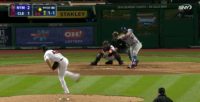Pick out a problem with the Mets. The offense? The pitcher’s mechanics? Their starting to have some players get banged up? These and much more are very fair and valid. None of these are the biggest concern with the Mets.
The biggest concern is Jaxon Anthony deGrom.
There are some unspecified medical issues with deGrom’s newborn son. Fortunately, it’s not life threatening. Whenever something is wrong with your child whatever good news you receive is good news. That doesn’t mean the situation isn’t serious. Jaxon and his parents need every single one of your prayers right now. The only thing that matters is Jaxon is alright, and he goes on to lead a happy and healthy life.
At this time, deGrom needs to be a father and husband. He should take as much time as needed. With that said, I do wish the Mets put him on the DL rather than the bereavement/medical leave list. If deGrom went on the DL, his return would be open ended. With the bereavement/medical leave list, the Mets and deGrom are forced do make a decision after 3-7 days.
However much time deGrom and his family needs, he should take it. As far as I’m concerned, deGrom can miss the whole season. His son comes first. No, I don’t care if it costs the Mets the postseason or World Series. Sure I’ll be disappointed, but some things are more important.
My thoughts and prayers today are with Jaxon, Stacey, and Jacob deGrom.
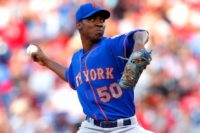
With the Mets bullpen on fumes from a very short Steven Matz start and Logan Verrett making a spot start in place of an injured Jacob deGrom (our prayers are with him and his family), the Mets recalled Rafael Montero to add a fresh arm to the bullpen mix. The Mets needed an extra arm after the bullpen pitched 7.1 innings on Monday without any contributions from their long man. It was a waste of a move. At this point, it’s clear Montero is in Terry Collins’ doghouse, and Collins won’t use him until he’s burned out all of the other arms on the bullpen.
On Wednesday, Collins controversially pitched Jim Henderson despite him having problems locating his pitches and throwing more pitches he ever had in one game the previous night. Collins then proceeded to use Hansel Robles, who pitched 2.2 innings on Monday. Collins went to four relievers that day to preserve a 2-1 win.
On Friday, the Mets had a four run lead. Collins first turned to Antonio Bastardo to get out of a sixth inning jam. He then have way to Robles for 0.1 of an inning. At that point, the Mets had a four run lead in the eighth inning. Collins turned to Addison Reed to get the last six outs. Reed got five and allowed two runs in the process. Collins decided to let Jeurys Familia pitch for the fourth time in four games. Despite allowing a run, he recorded the save.
At no point in either of these games did Montero so much as warm up.
An argument can be made for not using Montero Wednesday because of how close the game was. The Mets were in the midst of a frustrating losing streak, and Collins wanted his best arms out there to get the win. With that said, there’s no reason why Montero didn’t pitch on Friday. After Bastardo got out of the jam, the Mets had a four run lead. That was the perfect spot for Montero.
Instead, Collins asked both Bastardo and Reed to pitch over an inning. He asked two middle relievers to pitch more than an inning rather than asking the long man in his bullpen to pitch more than an inning. Collins was ready, willing, and able to once again tire out his bullpen rather than putting Montero in a game to preserve a four run lead. At this point, it’s fair to say either Collins doesn’t trust Montero, has him in his doghouse, or both.
It’s strange to think it’s reached this point when Collins has tried to get the most out of Montero.
Last August when things were starting to take off for the Mets, Collins drove to Port St. Lucie to have a conversation with Montero in order to tell him the Mets still needed him. At that time, Montero was dealing with shoulder issues. The Mets insisted there was nothing wrong while Montero felt like it prevented him from pitching. Montero tried to make that comeback, but he would have a setback in a rehab start. His season was over.
In Spring Training, Collins again took time to deliver a special message for Montero. As Tim Rohan of the New York Times reported, Collins told Montero, “Get your act together. We haven’t forgotten about you. We still want you.” Collins gave him the start in the Mets first Spring Training game. Montero allowed the first five guys to reach base. In total, he allowed four runs, four hits, and two walks in one inning of work. Montero would not pitch in another game, and he would be in the first group of Spring Training cuts.
At this point, the Mets need Montero. He’s gotten his act together with some mechanical adjustments in Triple-A. However, it’s too little too late. Collins has either forgotten him or doesn’t want him anymore.
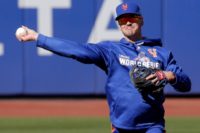
Due to the stress Jacob deGrom‘s injury and Steven Matz‘s short start out on the bullpen, the Mets were forced to call-up Rafael Montero to add a fresh arm to the bullpen. Rather than out deGrom on the DL or demote another pitcher, the Mets sent down Eric Campbell. Even with deGrom looking more and more like he will miss his next start, the Mets still won’t put him on the DL. Essentially, the Mets robbed Peter to pay Paul.
With a weekend Interleague series in Cleveland, the Mets can get away with a short bench. While it does limit their ability to pinch hit and make defensive substitutions, they should be able to navigate the situation because they won’t have to pinch hit for a pitcher. However, come Monday, they’re back to playing National League ball, and they’re going to need a full bench.
Whatever your feelings on Campbell is, he’s not going to be eligible to be recalled. Unless deGrom (or someone else) goes on the DL, Campbell will have to spend 10 days in the minors. Looking over the Mets 40 man roster, there would be three eligible candidates: Dilson Herrera, Matt Reynolds, and Brandon Nimmo. Now with one extra spot left on the 40 man roster due to Zack Wheeler being on the 60 day DL, the Mets could recall another player like a Ty Kelly.
In reality, the decision is between Reynolds and Kelly. Nimmo isn’t quite ready, and even if he was, the last thing the Mets need is another outfielder. Herrera still hasn’t started playing games in the field yet due to a sore shoulder, and even if he has been, the Mets see him as the second baseman of the future. They’re not wasting service and development time for him to be on the bench.
Kelly is 27 years old, and he has yet to play in the majors. He plays second, third, and the corner outfield positions. He’s a very disciplined hitter, who is extremely selective at the plate. For reasons that aren’t completely clear, he’s spent five seasons in Triple-A, and he’s never played a major league game. Overall, the truth really is Triple-A is his ceiling. At best, he’s a AAAA player.
Even if that assessment was wrong, it’s still not time to call-up Kelly. First, the Mets would have to add him to the 40 man roster and would not be able to denote him unless he clears waivers. Additionally, his skill set doesn’t match what this team needs. There’s no room for him in the outfield. Terry Collins is going to play Neil Walker almost everyday. So in essence, while Kelly has some versatility, the positions he plays do not match the Mets’ needs.
Accordingly, Reynolds is the player the Mets need to recall. During Spring Training and this early minor league season, Reynolds has played every infield position but first. His addition to the major league roster would create more flexibility across the infield. It would permit Collins to sit both Asdrubal Cabrera and Lucas Duda in the same game. Additionally, it would permit Collins to double switch with any player with the full knowledge that there’s another player on the bench who is fully capable of playing any position should another double switch be needed or there was an injury.
Offensively, Reynolds is a right hand batter who profiles better at the next level than Kelly. He’s not as patient as Kelly, but then again no one is. Reynolds profiles as a gap to gap line drive hitter. He does have more pop in his bat than Kelly. More importantly, at the very least, Reynolds projects as a bench player.
If Reynolds is going to wear a Mets uniform past smiling and waiving before Game One of the NLCS, he’s going to be a super-utility man in the mold of Flores or Joe McEwing. Reynolds has worked hard at it during the offseason and Spring. He knows this is his future, and he’s fully embraced it.
Better yet, he’s scorching hot right now. He’s hitting .353/.476/.529 with a homerun in five games. In those fives games, he’s played second, third, and short. At this point the only plausible reason for not calling up Reynolds is the Mets want to have a short bench.
Reynolds has earned his shot, and he’s playing well. It’s time for the Mets to call-up Reynolds.
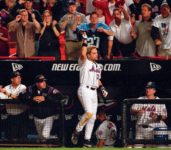
Thanks to three people, Anthony Scaramucci, Tony Lauto, and another in identified buyer (Oliver Stone?), Mike Piazza‘s 9/11 jersey is safe. The trio agreed that the jersey will forever rotate between Citi Field, the 9/11 Museum, and the Baseball Hall of Fame. These three people stepped up and did what was right and what was needed.
They had to step up because Mets ownership wouldn’t. As Kevin Kernan of the New York Post reported, the Mets never made a bid for the jersey.
To be fair, let’s not revisit the past here. We don’t know why the jersey was sold. It might’ve been the result of the financial troubles the Wilpons experienced as part of the Madoff scandal. It could’ve been an oversight. It’s possible no one realized the importance of the jersey. Maybe, just maybe, it was never supposed to be sold in the first place, but it was due to oversight. Fact is we’ll never know why it was sold. Most agree that in retrospect, it was wrong to sell the jersey. The Mets organization admitted as much in their statement to the New York Post stating, “We made a mistake in selling the jersey and Jeff [Wilpon] called Mike [Piazza] to express our regret in doing so.”
With the jersey up for sale, the Mets got that rare opportunity to right a wrong. They chose not to do so. They didn’t despite Jeff Wilpon assuring Piazza the Mets contacted the seller and were “making a concerted effort to get the jersey back.” They didn’t. Instead, they let someone else step in and purchase it.
At this point, it’s inexcusable. They told their newly elected Hall of Famer, they were going to make a concerted effort, and they didn’t. They got lucky because three people not only purchased it, but also agreed it should be on permanent display instead of in one of their homes. The thing is as the owners of that jersey that was their right. That was what the Mets risked.
At this point, we just have to ask,”Why?”
Why didn’t the Mets realize the jersey’s importance in the first place? Why didn’t they make an effort to buy the jersey? Why did they not keep their promise to Piazza? Why didn’t they understand what the jersey meant to the fans? Why were they willing to let the jersey to possibly be sold to someone who didn’t feel the obligation to display the jersey publicly?
The answer to all of these questions, and many more is, at the end of the day, baseball is a business. The owners only care about the fans to the extent that they want to create an environment suitable enough for them to spend as much of their disposable income on the team as possible. To Mets ownership, the Piazza 9/11 jersey didn’t have any special meaning. Rather, it was a jersey: (1) that could be sold for a profit; and (2) whose current purchase price was cost prohibitive. Pure and simple, these were business decisions.
The Mets will continue to make business decisions like they’ve always done. They’ll sell bricks which line the outside of Citi Field, but they won’t erect a Tom Seaver statue. They won’t sign a player like Yoenis Cespedes, despite the fans’ attachment to him, unless it is at a price suitable to them. For better or worse, that’s how the Mets operate.
And that’s all the Piazza 9/11 jersey decisions were to them – business decisions.
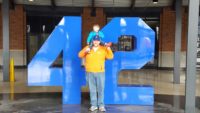
Deep down in each and every one of us is a snob. We prefer to see shows on Broadway instead of the community theater. We prefer our steaks to come from a steakhouse instead of a diner. We’d prefer to watch the Masters over the Shell Houston Open. There’s nothing wrong with a community theatre, diner steak, or the Shell Houston Open. In fact, they can all be quite good. However, deep down, we want to see the best of the best.
That’s part of the enduring legacy of Jackie Robinson.
No, this aspect of his enduring legacy is not discussed all that frequently. Mostly, it’s because it may be the least important part of his legacy. Robinson lived in a different world, even a different United States, than we do today. His breaking the color barrier pre-dated the end of segregation. Robinson playing for the Dodgers was not just important for baseball, but also for civil rights.
But make no mistake, it was important for baseball.
Because of Jackie Robinson’s breaking of the color barrier, we get to see the best players all play together and against one another. We get to see Ichiro Suzuki try to get to 3,000 hits this year. We get to see Carlos Beltran try to hit his 400th homerun this year. We just saw Bryce Harper hit his 100th homerun. CC Sabathia looks to record his 2,600 strikeout and move into the Top 25 in that category all time.
Each and every single one of these players, and the countless others not mentioned, are doing this at the highest level. As players, these players know they are truly exceptional because they are unequivocally doing this against the best players in the sport regardless of creed, race, or religion. As fans, we get to see the best players from around the world play baseball at the highest level. No matter what, we get to see the best of the best.
Thank you Jackie Robinson for making that and so much more possible.

On Wednesday, Logan Verrett pitched six scoreless innings against at the Miami Marlins. Verrett allowed three hits, two walks, and six strikeouts. It was a remarkable start for a pitcher who was never supposed to be here.
Heading into the 2015 season, the Mets declined to put Verrett on the 40 man roster thereby exposing him the the Rule 5 draft. He was selected by the Orioles, who waived him when it was apparent he was not making their team. He was picked up by the Rangers, who made their Opening Day roster.
In very limited duty for the Rangers Verrett struggled. He pitched nine innings in four appearances with a 6.00 ERA and a 1.667 WHIP. Verrett was offered back to the Mets, who accepted him back and sent him to Triple-A.
Verrett first came up with the Mets in June to help an exhausted bullpen. He would pitch 12.1 innings over the course of six appearances. He had a sterling 0.73 ERA and 0.649 WHIP. Batters were only able to hit .100/.178/.100 against him. He recorded his first save. Despite this stellar performance, he would be sent back down to the minors to make room for Jenrry Mejia, who was returning from his first PED suspension.
In Verrett’s second stint with the Mets in August, he would further prove his value. With the Mets needing to keep their young pitching staff fresh for the postseason, especially Matt Harvey, Verrett was called upon to make some spot starts. In his first start, he threw eight shutout innings in Coors Field of all places. He would follow that up with a couple a relief appearances and another strong spot start against the Marlins.
In total, Verrett would pitch in 14 games with the Mets making four spot starts. He was 1-1 with one save, a 3.03 ERA, and a 0.879 WHIP. In a season of incredible performances from a myriad of players, it’s easy to overlook Verrett’s contributions.
Then again, it’s been easy to overlook Verrett. In an organization that seemingly churns out nothing but pitchers throwing 95 MPH plus striking people out left and right, Verrett uses all four of his pitches, including a 91 MPH, to get outs. While each and every Mets draft pick gets attention, he simply flew under the radar honing his skills and becoming a better pitcher. Perhaps that is why he became the first ever draft pick from the Sandy Alderson regime to play in the majors.
In 2016, Verrett made the Opening Day roster, and he’s back to doing what he does best – pitching in whatever role the Mets need. In his spot start in place of the ailing Jacob deGrom, Verrett threw six shutout innings. Not only did he help prevent the Mets from getting swept by the Marlins, but he also pitched somewhat deep into the game to give a fatigued Mets bullpen some rest.
As we know, the Mets never intended to have Verrett start that game. Frankly, no one thought he would pitch a game for the Mets. However, because the Mets got lucky with the Orioles and Rangers overlooking how good he truly was, like the Mets once did themselves, Verrett is pitching in the majors showing the world what a truly talented pitcher he is.
No one is going to overlook him ever again.

On April 15, 1997, President Clinton attended a Mets-Dodgers game in Shea Stadium. He was there to commemorate the 50th Anniversary of Jackie Robinson breaking the color barrier. During the pre-game tribute, it was announced that 42 would be retired throughout baseball. Afterwards, a diverse group of Mets players would play in a game against a group of diverse Dodgers players. Can you name the Mets starting lineup on this momentous day? Good luck!
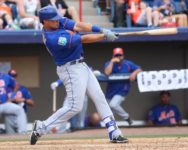
During Spring Training, Travis Taijeron introduced himself to many Mets fans by hitting .368/.432/.658 with two homeruns and 11 RBI. He played so well he was awarded the John J. Murphy Award, which is given to the top rookie in his first ever Spring Training.
It’s somewhat ironic that Taijeron wins that award as the 27 year old’s chances of ever playing for the New York Mets dwindle by the day.
In Taijeron’s major league career, he has only played the outfield. As Mets fans already know, the major league club is saturated with outfielders. In fact, the Mets have two major league caliber starters, Juan Lagares and Alejandro De Aza, as reserves. The Mets major league depth, and the fact that Taijeron is not on the 40 man roster makes it highly unlikely he will get called up to the majors either this year or in subsequent years.
No, in order for Taijeron to put himself into position to ever be called up to the majors, he’s going to have to become a more versatile player. It’s what the Mets are working on now with Taijeron’s AAA teammate Matt Reynolds. It’s a big reason why Eric Campbell made the Opening Day roster. In his short major league career, Campbell has played every position but pitcher, catcher, and centerfield. By the way, Campbell has worked at being capable enough behind the plate to become an emergency catcher.
So, if Taijeron ever wants to play in the majors, he’s got to pick up a first baseman’s mitt. He has to work on the position whenever he can. He needs to show the Mets organization that he is more than just an outfielder. He needs to show them he can be a versatile part of a major league bench. These are the types of things a 27 year old minor league player, who was drafted in the 18th round, needs to do.
Fortunately for him, if he becomes proficient. The Mets have no prospect standing in his way from playing some AAA games at first. The current AAA first baseman is Marc Krauss, who is nothing more than minor league depth. He’s a career .187/.255/.324 major league hitter. There is no scenario in which he ever plays for the Mets.
However, with the way Taijeron hits, he could play in the majors. Last year in AAA, he hit .274/.393/.536 with 25 homeruns and 71 RBI. His season was good enough to earn him an invitation to Spring Training where he made the most of his opportunities. He showed the Mets he has pop in his bat, and he can play the outfield well. Now, he just has to show them he can play one other position.
The Mets organization has some interest in seeing Taijeron play first base. It would permit Reynolds to play some outfield as he tries to become more versatile himself. With respect to Taijeron, the Mets could have a bench bat that can draw walks and hit for some power. As such, putting Taijeron at first would permit the Mets to extract the most value possible out of two prospects. Therefore, allowing Taijeron to play first would be in the Mets’ best interests.
Taijeron has real talent, which may or may not translate to the majors. However, we will never know if it could unless he makes himself versatile enough for the Mets to call him up to the majors. It’s time for Taijeron to put on a first baseman’s mitt.
Editor’s Note: this first appeared on metsminors.net

After Johan Santana threw 134 pitches on a surgery repaired shoulder to throw the first no-hitter in Mets history, Terry Collins was in tears. He seemed distraught. In the post-game press conference, Collins called Santana his “Hero,” and he was prescient in saying:
I’m very excited for him, but in five days, if his arm is bothering him, I’m not going to feel good.
As we know, even though Santana would make 10 more starts, his career effectively ended that night. He would need another shoulder surgery in the offseason. Between that surgery and other injuries, Santana has never pitched in another big league game.
When Collins was interviewed by Phil Taylor of Sports Illustrated three years later, Collins expressed his remorse. He would say, “It was without a doubt, the worst night I’ve ever spent in baseball.” Now, no one really knows what effect this game had on the need for Santana to have a second surgery. However, for his part, Collins thinks the no-hitter had a lot to do with it:
I was aware of what the wear and tear of that night could do to him, and basically, the worst-case scenario happened. To throw that amount of pitches with that much pressure and that much adrenaline going, it can beat you down. And it did.
If Collins truly believes that, it makes what he did with Jim Henderson all the more indefensible.
Henderson has come a long way to get here. He’s had two shoulder surgeries himself. He fought against all odds to make the Mets Opening Day roster. Not only did he make the roster, he quickly established himself as a very important part of the Mets bullpen.
So far this year, Henderson has pitched in five of the eight games the Mets have played. On Tuesday, he threw 34 pitches, which was the most he’s ever thrown in one game. Wednesday was a day game. The Mets added Rafael Montero to the roster so the Mets would have a full bullpen for the game. With the score tied 0-0 in the seventh inning, Collins put Henderson in the game.
Before Wednesday’s game, Henderson’s fastball averaged 95 MPH. On Wednesday, he was sitting around 89 MPH. He allowed a single and two hits before Collins pulled him from a game he shouldn’t have entered in the first place. Collins excuse?
TC: "Henderson said before the game that he felt great."
— Steve Gelbs (@SteveGelbs) April 13, 2016
It’s difficult to believe that Collins used this as a justification. He says he is troubled by Santana’s no-hitter, and he thinks it had a profound impact on effectively ending his career. Why would he willingly do the same thing again with another player? Why would he go to Henderson when there were other, fresher options? It doesn’t make sense.
It should be noted that Collins had a different tone in Wednesday’s press conference than Santana’s. Collins was fired up. There was no hint of him fearing for Henderson’s future.
Collins thought this was a must-win game, but it’s a stretch to believe he would sacrifice a player’s health for it. Collins said he was desperate, but there has to be a line. Collins might’ve wanted to respond to people questioning the Mets effort, but putting a player’s health and career in doubt, you prove nothing.
At the end of the day, Terry Collins has shown he has learned nothing. While we all understood him leaving Santana in, there was no excuse for pitching Henderson there. Collins could’ve ended someone’s career for what really was just another April game. Overall, Mike Vaccarro put it best when he chastised Collins:
Shame on Terry Collins. That wasn't just reckless game managing, but it put his pitcher's health in peril. #Mets
— Mike Vaccaro (@MikeVacc) April 13, 2016
Collins has had some nice moments as the manager of the Mets. Wednesday wasn’t one of them. Collins once called Santana’s no-hitter the worst night of his baseball life. Wednesday could’ve been the worst day of Henderson’s professional life, but Collins showed no remorse. Collins may be haunted by Santana’s no-hitter, but he has clearly showed he’s learned nothing from it.
Editor’s Note: this was first published on metsmerizedonline.com

